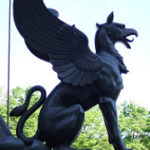05 Jun History of the Griffin – And Why It’s In Our Logo
 With the head of an eagle and body of a lion, it’s no wonder that griffins, a type of mythological creature, often appear in pop culture. From a gargoyle of a griffin outside the headmaster’s office in Harry Potter to its appearance in Rick Riordan’s Trials of Apollo, these creatures remain in mainstream culture despite being thousands of years old. We’re big fans of the ancient griffin at Boyum Law Firm, too. In fact, this creature is the focal point of our logo. Read on to learn more about the history of the mythical griffin and why we’ve chosen one to symbolize our business.
With the head of an eagle and body of a lion, it’s no wonder that griffins, a type of mythological creature, often appear in pop culture. From a gargoyle of a griffin outside the headmaster’s office in Harry Potter to its appearance in Rick Riordan’s Trials of Apollo, these creatures remain in mainstream culture despite being thousands of years old. We’re big fans of the ancient griffin at Boyum Law Firm, too. In fact, this creature is the focal point of our logo. Read on to learn more about the history of the mythical griffin and why we’ve chosen one to symbolize our business.
Origins of the griffin
Griffins are frequently used in modern day media forms like movies, but these creatures are actually thousands of years old. They didn’t originate with the Greeks, either, which is a common myth. According to the Encyclopedia Britannica, the original griffin probably came from the Levant, also known as the Eastern Mediterranean, in the 2nd millennium BCE. These mythical creatures then spread into western Asia, the Middle East and Greece by the 14th century BCE. Today, they’re still in mainstream culture, especially in fantasy books and movies.
Characteristics of the griffin
While the idea of griffins spread all over the world, the representation of these creatures varied from culture to culture. For example, the Greek griffin typically featured the mane of a lion while the Asiatic version of the creature had a crested head. During the Iron Age, both cultures made statues of the griffin with its beak open and tongue showing. Regardless of the physical variations in the griffin’s appearance, most cultures generally agreed on its attitude and personality. Griffins were said to be loyal, protective creatures. They were believed to guard their treasures fiercely – whether that treasure be a person, place, or pile of gold. The loyalty and protectiveness of the creature helped popularize the griffin and earned it its staying power throughout history.
Adaptation of the griffin through history
Griffins appear in the artwork and legends of a variety of cultures throughout history. Statues, paintings, and busts all feature the winged creature. The griffin also appears in architecture. Medieval churches and buildings would use the griffins form to create gargoyles. Over time, the creature and its representation even evolved to be used in family crests. For example, the descendants of Welsh settlers with the last lame Griffin have a family coat of arms that features a griffin standing on its hind legs in the middle of the crest. Nowadays, readers and movie watchers can see a griffin-horse hybrid, called a hippogriff, in Harry Potter. Some businesses, like our own, include the griffin in their logo.
Why we’re big fans of the griffin
With its eagle head and lion body, the griffin is the animal king of both land and sky. As previously mentioned, griffins are fiercely protective of their treasure – be it gold or other finery, which is why some placed the creature on their family crest and others used the its likeness to create gargoyles. At Boyum Law Firm, we strive to be real-world griffins. We work our hardest to fiercely protect the financial and emotional treasures of you and your loved ones – no family crest required. We know it can be difficult to trust another person with your financial and emotional valuables. However, like the loyal griffin, we’ll stay by your side to protect what you value.
How can Boyum Law Firm help you?
Boyum Law Firm can help you and your loved ones with your estate planning, probate, and Medicaid planning needs. To contact Boyum Law Firm, click here.



